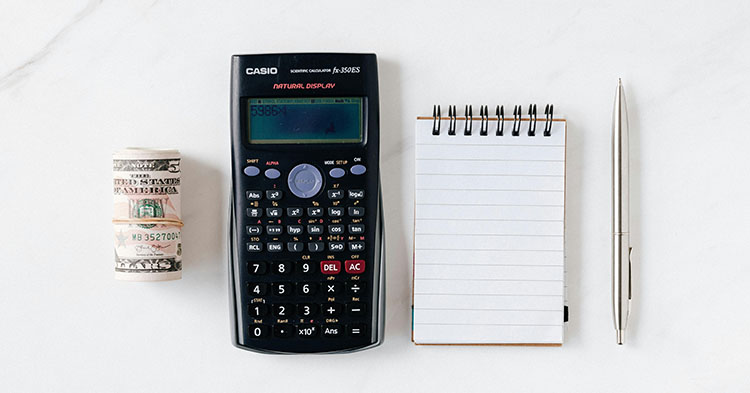Just the word “budget” is enough to make many people nervous. They might think of budgets as restrictive, but a budget can give you more financial freedom. It’s all about creating a plan that works for your lifestyle and sticking with it.
A good budget can help you reach your financial goals — and budgeting is easier than you may think.
How to Budget Your Money
Budgeting is about understanding where your money goes and making informed decisions to reach your financial goals. Here are a few steps to help you get started:
1. Calculate your monthly income.
To create a good monthly budget, you need to figure out how much money you’re bringing home each month. This includes your paycheck, money from side hustles and any other form of income you regularly receive. Knowing how much you earn each month lays the groundwork for the rest of the budgeting process.
Knowing your take-home pay is important because it helps you build a realistic and practical budget. It can help you set achievable financial goals and ensure that every dollar goes where it should.
2. Add up your monthly expenses.
After calculating your monthly income, you should then list out all of your monthly expenses. You can look at your bank statements to see what expenditures you run into every month. Your list should include fixed expenses like rent, student loan payments, car payments and any monthly subscriptions, such as streaming services. It should also include variable expenses like groceries, transportation and entertainment.
Remember to include the smaller expenses too. Coffee trips, occasional treats and impulse purchases may seem insignificant on their own, but when added up they can significantly impact your budget. You don’t have to cut out your daily visit to the coffee shop, but you should budget for it. Understanding your spending habits, both big and small, is essential to creating a budget that reflects your lifestyle.
3. Set realistic spending and savings goals.
Now that you have a clear picture of your income and expenses, you can set spending and savings goals. Start with the essentials. These are the expenses that you must meet each month, such as rent, utilities, child care and food. After you’ve covered these, you can then budget for your discretionary spending. This can include things like entertainment, dining out or shopping. Setting these goals requires you to balance what you need, what you want and what you can reasonably afford.
Your budget should also include savings. Whether you want to build an emergency fund, save for some fun or invest in your future, it’s important to set aside a portion of your income. Regularly contributing to your savings account can help ensure your financial future is secure.
4. Stick to your spending goals.
Sticking to your budget is key, so it’s important to track your spending. You can use a simple spreadsheet or you can use a budgeting app that connects directly to your bank account. Remember, it’s okay to have occasional slips-ups, but try to stay on track as much as possible.
5. Adjust your budget as needed.
Your financial situation is always changing. You could get a new job, move homes or have an unexpected expense pop up. As life changes, it’s important to review your budget and ensure that it’s still serving you.
Why Is Budgeting Important?
Budgeting is important because it allows you to take control of your financial situation. By making a plan for your money and keeping track of where it goes, you can make the right decisions to reach your goals. It’s like a roadmap that helps you stay on the right path through your financial journey and allows you to navigate the occasional roadblock or detour.
Unfortunately, many financial skills like budgeting aren’t always taught in school. When people don’t have a chance to gain this financial know-how, it can lead to challenges in money management. Luckily, it seems that more and more states are requiring personal finance to be a part of the curriculum.
What Are Some Budgeting Strategies?
There are many different budgeting strategies you can try. You can experiment to find the one that’s the best fit for you. Here are a few common strategies:
50/30/20 rule. This is a simple budgeting guideline that suggests you allocate 50% of your income to needs, 30% to wants and 20% to savings or debt repayment. This rule can help you create a balanced budget that covers necessities, allows for fun and helps build your savings.
Envelope system. This is a cash-based budgeting system where you divide your spending money into separate envelopes. You can categorize your envelopes for things like dining out, shopping or coffee. When the envelope is empty, you stop spending in that category until the next budget period. This budget method is effective at controlling overspending and using cash can make you more conscious of the amount you are spending versus swiping a card.
Zero-based budgeting. In this budgeting plan, every dollar has a job. You allocate every dollar to a specific expense or savings goals so that your income minus your expenses equals zero. With this budgeting strategy, you won’t have any extra money at the end of the month because each dollar has already been saved or spent. This budget style can make it easier to spot where you can cut unnecessary spending.
Pay yourself first. This budgeting plan prioritizes savings. Just as the name describes, pull money from your checking account and deposit it into a savings account before paying for anything else. This approach can help you reach your savings goals.
What Goals Can Budgeting Help Me Reach?
Building an emergency fund. Budgeting can help you put money aside for unexpected expenses. An emergency fund acts as a safety net, helping to make sure you’re prepared for unexpected financial emergencies, without relying on credit cards or loans.
Paying off debt. By allocating your money well and tracking your spending, you can pay down your debt faster. Many people have debts they’d like to pay off like personal loans or credit card debt. Budgeting helps you identify areas where you can cut back on spending. From there, you can choose which debt to pay off first, and redirect your savings.
Saving up for fun. Budgeting doesn’t mean that you have to cut out all fun. It just means you have to plan for it. If there’s a trip you want to go on or a big show you want to get tickets to, a budget can help you save up to reach these goals. It allows you to afford the things you want to do without overspending or compromising your financial health.
Saving for retirement. A budget can help you reach long-term goals as well. By regularly setting aside money for your retirement fund, you can help ensure a more secure and comfortable future for yourself.
Are There Tools to Help Make Budgeting Easier?
There are many tools available to help you budget — whether you’re a first-time budgeter or just want some extra budgeting tips. There are a ton of apps and online tools, from basic expense trackers to comprehensive financial planning tools. Plus, some of the tools are offered for free. You can find templates and budget calculators that help you visualize your expenses and set realistic spending limits for each category.
There have also been thousands of books written about budgeting and personal finance. Books can offer a lot of knowledge and more budgeting strategies. They often come with budgeting worksheets and other tools to help you get organized.
Budgeting tips from an expert
“The Power of the Anti-Budget. Traditional budgets can feel restrictive, leading many to abandon them altogether. Instead, try the concept of an anti-budget. Rather than tracking every penny, focus on your savings and financial goals first. Allocate a fixed percentage of your income to savings, investments, and debt repayment. Whatever remains is yours to spend guilt-free. It provides structure while allowing for flexibility.
“Utilize the 30-Day Rule for Non-Essential Purchases. Impulse purchases can derail even the most disciplined budget. Implement the 30-day rule: if you’re eyeing a non-essential item, wait 30 days before buying it. This helps distinguish between impulse desires and genuine needs. Often, the initial desire fades, saving you money and preventing clutter.
“Embrace the Envelope System Digitally. The envelope system, where you allocate physical cash to different spending categories, is a classic budgeting technique. Give it a modern twist by using digital tools. Create separate savings accounts or use budgeting apps to digitally allocate money to different categories. It maintains the essence of the envelope system without the need for physical cash.
“Shift Your Mindset. Budgeting as a Financial GPS. Rather than viewing a budget as a constraint, see it as your financial GPS. It guides you toward your destination – your financial goals. When faced with a financial decision, ask yourself if it aligns with your budget and goals. This perspective shift empowers you to make mindful choices that contribute to your financial well-being.”
John Browning, CEO & Principal
Guardian Rock Wealth
DISCLAIMER: This content is for informational purposes only, and is not intended as financial, investment, or legal advice. Consult a licensed professional before making financial decisions.
Article Contributors

John Browning, CEO & Principal
With 30 years on Wall Street and decades of experience in financial planning and advisory, John Browning is a seasoned financial advisor, founder of Guardian Rock Wealth, and the author of the best selling book Build a Life, not a Portfolio.




